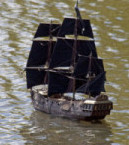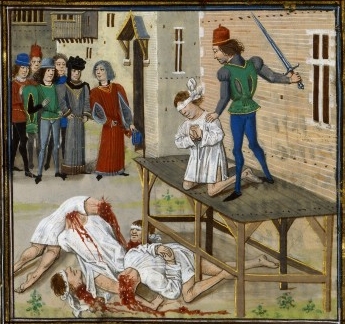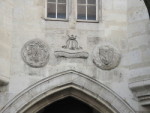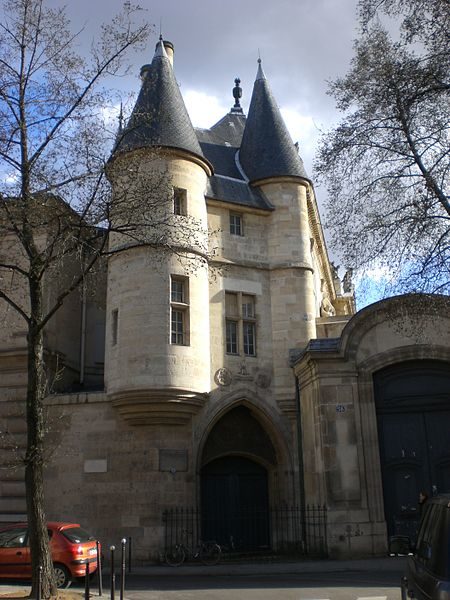One of my favorite historical blog sites is written by my friend, Susan Abernethy (“The Freelance History Writer”). She primarily writes about medieval Europe and in particular, England. Her blogs are professionally written, interesting, and well researched. She recently wrote a blog entitled Swashbuckling Personalities in History.
Her blog reminded me of a woman I highlighted in my recent book, Where Did They Burn the Last Grand Master of the Knights Templar?—A Walking Tour of Medieval Paris.
“The Lioness of Brittany” was Jeanne de Clisson (1300–1359).

The lords of Clisson came from Brittany dating to the 10th century. Olivier IV de Clisson (1264–1343) was married to Jeanne when he was beheaded on orders from King Philippe VI the Fortunate (I suppose Olivier wasn’t as fortunate as the king).
De Clisson had secretly sided with the English monarch, Edward III, after vowing his loyalty to Philippe. The French king discovered the treachery and invited Olivier to a jousting tournament whereupon Olivier was arrested and imprisoned in the Grand Châtelet in Paris.

Olivier IV was hauled off to the great Parisian marketplace called Les Halles (nicknamed the “belly of Paris”) and executed. His body was hung in the Gibet de Montfaucon while the head was sent to Nantes in Brittany to be stuck on the Sauvetout gate. Well, his widow didn’t take too kindly to how the king and his nobles treated her husband (or his body or his head).
In fact, she probably had good reason to be upset since traditionally, it was only petty criminals whose bodies were put on public display after being executed. Despite this disgrace to the Clisson family, Jeanne took her two sons to Nantes to view their father’s head.
Jeanne the Pirate
Jeanne sold off all the Clisson estates and bought five warships. She had them painted black and equipped with blood red sails.
For more than a decade, Jeanne sailed up and down the coast capturing French vessels and beheading every French noble she could find. She would always leave one or two of them alive so they could report back to the king about her exploits. In other words, Jeanne became what Susan calls “swashbuckling personalities.” I would call Jeanne a pirate.
The Lioness of Britanny ended up moving to England and marrying an English lord. Her son, Olivier V de Clisson (1336–1407) became known as “The Butcher” after his reputation for taking no prisoners during the Battle of Auray in 1364. Perhaps seeing his father’s head on the gate and listening to his mother had something to do with his battle tactics? He became the Constable of France in 1380 and built his fortified residence, Hôtel de Clisson in Paris during the Late Middle Ages.
The Hôtel de Clisson is one of many stops in Volume Two of my medieval walking tour books.

It is located at 58 Rue des Archives. Actually, only the front entrance to the mansion still exists. This façade is adorned with the family’s coat of arms and you can see how it must have been heavily fortified. You’re also able to visit the family’s 13th-century castle located in the commune of Clisson in the Loire-Atlantique départment of France.
Château de Clisson

Olivier IV’s former residence (or what is left of it) is a great example of the remaining medieval structures in Paris—in fact, only three complete residences exist intact in Paris. You will experience many medieval sites during the walks in my two books but unfortunately; most of the medieval examples are only fragments of the original structures.
We need your help
Please tell your friends about our blog site and encourage them to visit and subscribe. Sandy and I are trying to increase our audience and we need your help through your friends and social media followers.
Thank You
Sandy and I appreciate you visiting with us. We have some exciting things on the horizon and we’ll keep you updated as we go along.
What’s New With Sandy and Stew?
Stew is working on creating the walks and individual stops for the next books: Where Did They Put the Gestapo Headquarters?—A Walking Tour of Nazi Occupied Paris (1940–1944). It’s clear that almost every building in Paris has a story associated with the Occupation years. It is a matter of identifying them and then prioritizing the stops for you. This is quite a process considering the tangents and rabbit holes I end up going down. But it is a lot of fun if not quite depressing at times. One of my friends, Mark Vaughan, has suggested a walking tour book based on Napoléon. What do you think?
We have a lot of stories and we’re looking forward to sharing these with you. Please continue to visit our blog site and perhaps you’d like to subscribe so that you don’t miss out on our blog posts, past and current.
Share This:
Follow Stew:
Find Stew’s books on Amazon and iBooks.
Please note that we do not and will not take compensation from individuals or companies mentioned or promoted in the blogs.
Walks Through History
Copyright © 2016 Stew Ross

